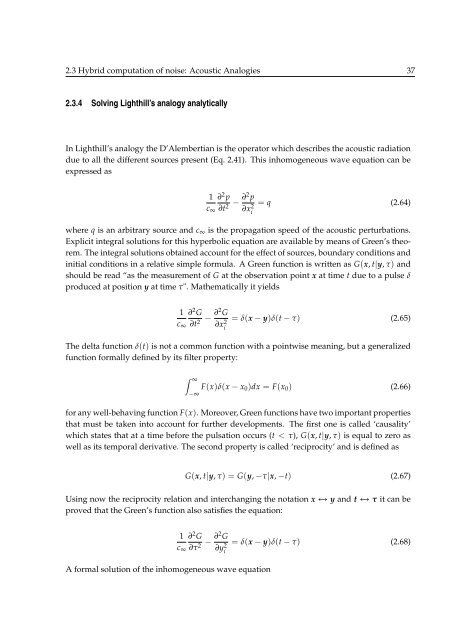THESE de DOCTORAT - cerfacs
THESE de DOCTORAT - cerfacs
THESE de DOCTORAT - cerfacs
Create successful ePaper yourself
Turn your PDF publications into a flip-book with our unique Google optimized e-Paper software.
2.3 Hybrid computation of noise: Acoustic Analogies 37<br />
2.3.4 Solving Lighthill’s analogy analytically<br />
In Lighthill’s analogy the D’Alembertian is the operator which <strong>de</strong>scribes the acoustic radiation<br />
due to all the different sources present (Eq. 2.41). This inhomogeneous wave equation can be<br />
expressed as<br />
1 ∂ 2 p<br />
c ∞ ∂t 2 − ∂2 p<br />
∂xi<br />
2 = q (2.64)<br />
where q is an arbitrary source and c ∞ is the propagation speed of the acoustic perturbations.<br />
Explicit integral solutions for this hyperbolic equation are available by means of Green’s theorem.<br />
The integral solutions obtained account for the effect of sources, boundary conditions and<br />
initial conditions in a relative simple formula. A Green function is written as G(x, t|y, τ) and<br />
should be read “as the measurement of G at the observation point x at time t due to a pulse δ<br />
produced at position y at time τ". Mathematically it yields<br />
1 ∂ 2 G<br />
c ∞ ∂t 2 − ∂2 G<br />
∂xi<br />
2<br />
= δ(x − y)δ(t − τ) (2.65)<br />
The <strong>de</strong>lta function δ(t) is not a common function with a pointwise meaning, but a generalized<br />
function formally <strong>de</strong>fined by its filter property:<br />
∫ ∞<br />
−∞<br />
F(x)δ(x − x 0 )dx = F(x 0 ) (2.66)<br />
for any well-behaving function F(x). Moreover, Green functions have two important properties<br />
that must be taken into account for further <strong>de</strong>velopments. The first one is called ‘causality’<br />
which states that at a time before the pulsation occurs (t < τ), G(x, t|y, τ) is equal to zero as<br />
well as its temporal <strong>de</strong>rivative. The second property is called ‘reciprocity’ and is <strong>de</strong>fined as<br />
G(x, t|y, τ) = G(y, −τ|x, −t) (2.67)<br />
Using now the reciprocity relation and interchanging the notation x ↔ y and t ↔ τ it can be<br />
proved that the Green’s function also satisfies the equation:<br />
1 ∂ 2 G<br />
c ∞ ∂τ 2 − ∂2 G<br />
∂y 2 i<br />
A formal solution of the inhomogeneous wave equation<br />
= δ(x − y)δ(t − τ) (2.68)
















